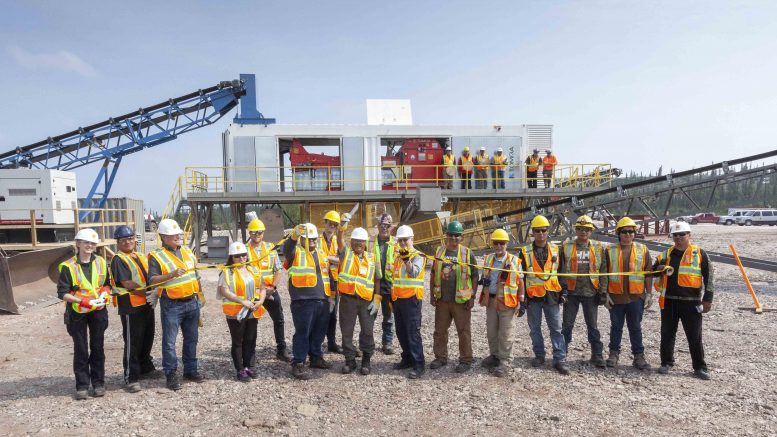The Yellowknives Dene First Nation plays a big part in the Nechalacho Rare Earth Mine on July 21, 2021 as seen on the grounds of the mine as they cut the rope to the opening of one of the mine’s operating machines, the sensor-based ore sorter. The ore sorter is a high tech and environmentally-friendly machine.
Jeremy Catholique and Cruze Jerome are two of the controls of the sorter guided by Russel Tjossem. YKDFN Elder and councillor Jonas Sangris gave a prayer for the workers safety and the protection of the land and water.
Drummers from YKDFN sang a prayer song on the catwalk of the ore sorter before cutting the ribbon.

YKDFN drummers helped to ceremonially commission the low impact TOMRA sensor based ore sorting machine at the Nechalacho Rare Earth Mine July 21. Cheetah Resources/billbradenphoto
William Lines, another YKDFN councillor joined Sangris and Mathew Edler, Cheetah Resources executive vice president in cutting the ribbon with a hunting knife.
The rare earth mine is the first to have a huge part be Indigenous-operated and included. The employment rate is 75 per cent of Indigenous people, with 5 per cent being youth. Lena Black, assistant chief executive officer of YKDFN says, “I believe that we have…five or six per cent of our youth right now with school just having ended. And then we have a lot of our members here.”
Catholique says, “It’ll give the community jobs. And the small communities like Łutselk’e, Yellowknife and Fort Resolution.” Catholique and Jerome have been working at the mine since early this year with training and moving towards the ore sorter.
“I started off hauling their core samples…that’s been here since 1971, when they first started.” says Jerome.
Cody Drygeese is the environmental officer for Cheetah Resources. One of the main things he’ll be doing is water sampling for toxicity and baseline environmental studies every three months that will track any changes for the future.
“There’s not a lot going on with our environment program…we’re still in the process of building it up right now. Eventually we’ll have the water settling pond in the waste rock storage area.”
As this is a pilot project, and the first for an Indigenous group to be heavily involved and on their traditional lands it is very beneficial for the people.
Lena Black says having YKDFN be involved in mining on its traditional territory is “very beneficial.”
“It’s a very proud moment for Indigenous organizations as well, specifically our organization to be included in a project that could potentially change the world,“ she says.
Being on traditional land they know the area more than the non-Indigenous people and though mining has its harmful impacts, the inclusion of the Indigenous people on their territory is more than other mines.
President and CEO of Det’on Cho Paul Gruner says, “It’s garnered a lot of interest, not only as Canada’s first rare earth project, but because of the Indigenous inclusion, and having that Indigenous piece, I think is a critical element. We’re certainly seeing that, through…the environment, social governance and increased Indigenous inclusion within the supply chain. And what we’re looking at is an opportunity where even equity participation on this project, so very exciting.“
The mine is said to be more environmentally friendly, one of the greenest mines there is for rare earth minerals. These minerals are needed for the technology in an emerging green energy sector. Gruner says there’s no chemicals as part of the extraction and sorting process. There are also high-efficiency building, but he says with being off-grid, the mine is powered through diesel generation.
The mine will include more culture, not only being out on traditional land, but with that comes an importance of perspective and who will be there. There will be both Indigenous and international peoples, learning from each other and most importantly the land.





